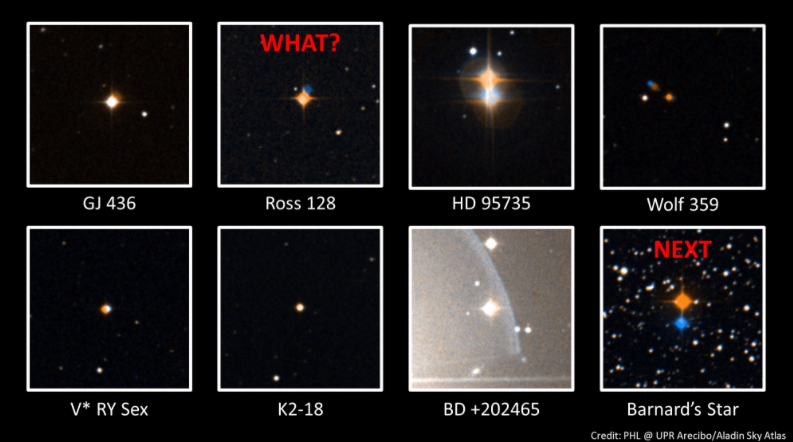
posted Jul 12, 2017, 1:31 PM by Abel Mendez [ updated 20 hours ago ]

We are conducting a scientific campaign from the Arecibo Observatory to observe red dwarf star with planets. These observations might provide information about the radiation and magnetic environment around these stars or even hint the presence of new sub-stellar objects including planets. So far, we observed Gliese 436, Ross 128, Wolf 359, HD 95735, BD +202465, V* RY Sex, and K2-18. Only Gliese 436 and K2-18 are known to have planets. Observations were done between April and May 2017 in the C-band (4 to 5 GHz).
Two weeks after these observations, we realized that there were some very peculiar signals in the 10-minute dynamic spectrum that we obtained from Ross 128 (GJ 447), observed May 12 at 8:53 PM AST (2017/05/13 00:53:55 UTC). The signals consisted of broadband quasi-periodic non-polarized pulses with very strong dispersion-like features. We believe that the signals are not local radio frequency interferences (RFI) since they are unique to Ross 128 and observations of other stars immediately before and after did not show anything similar.
We do not know the origin of these signals but there are three main possible explanations: they could be (1) emissions from Ross 128 similar to Type II solar flares, (2) emissions from another object in the field of view of Ross 128, or just (3) burst from a high orbit satellite since low orbit satellites are quick to move out of the field of view. The signals are probably too dim for other radio telescopes in the world and FAST is currently under calibration.
Each of the possible explanations has their own problems. For example, Type II solar flares occur at much lower frequencies and the dispersion suggests a much farther source or a dense electron field (e.g. the stellar atmosphere?). Also, there are no many nearby objects in the field of view of Ross 128 and we have never seen satellites emit bursts like that, which were common in our other star observations. In case you are wondering, the recurrent aliens hypothesis is at the bottom of many other better explanations.
Therefore, we have a mystery here and the three main explanations are as good as any at this moment. Fortunately, we obtained more time to observe Ross 128 next Sunday, July 16, and we might clarify soon the nature of its radio emissions, but there are no guarantees. We will also observe Barnard’s star that day to collaborate with the Red Dots project. Results from our observations will be presented later that week. I have a Piña Colada ready to celebrate if the signals result to be astronomical in nature.
UPDATE 2017/07/17: We successfully observed Ross 128 last night from the Arecibo Observatory. It was raining during the observations but this has a minimal effect on the C-band. SETI Berkeley with the Green Bank Telescope and SETI Institute's ATAjoined our observations. We need to get all the data from the other partner observatories to put all things together for a conclusion. Probably by the end of this week.
UPDATE 2017/07/19: We have all the Arecibo data ready to analyze. We are still waiting for the data from the other partner observatories to present a conclusion probably on Friday. This excellent article by Sarah Kaplan gives a personal perspective on this issue.